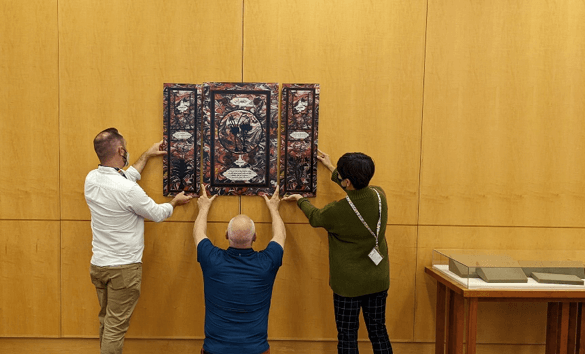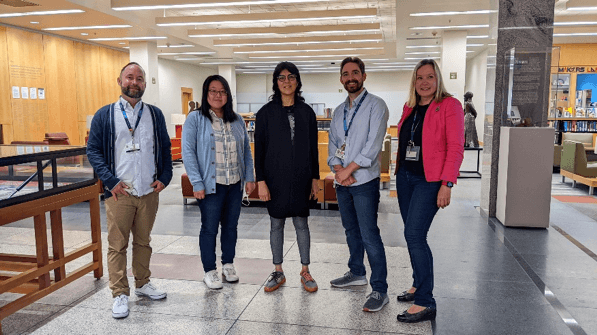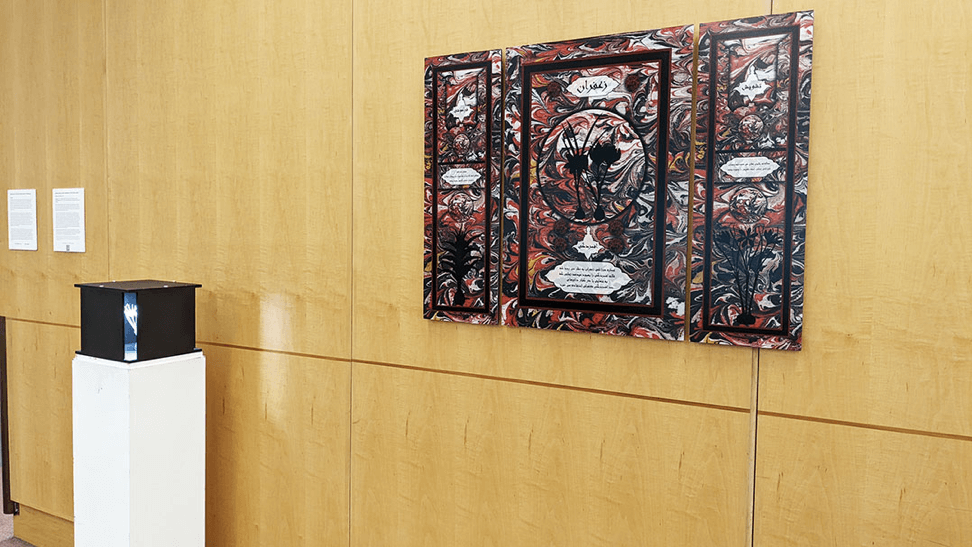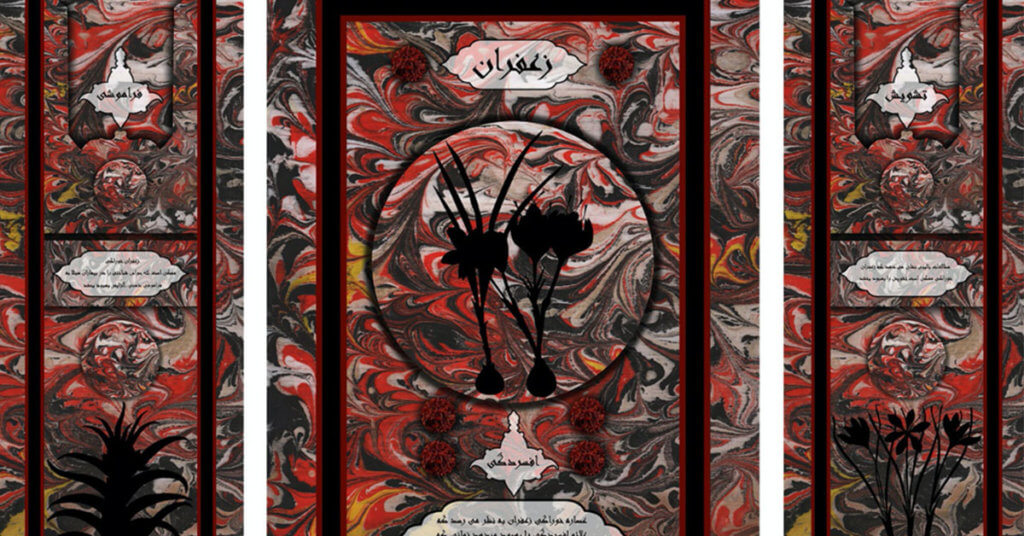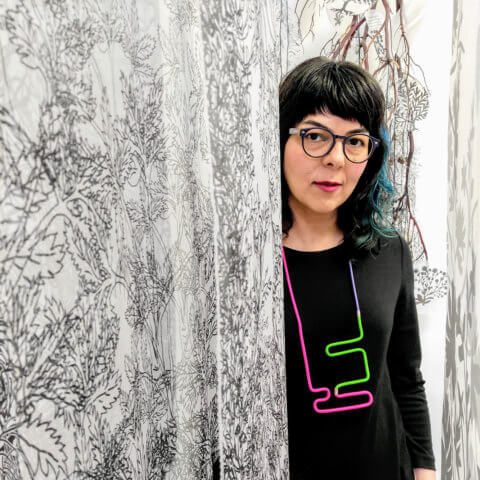Saffron, Saint of Spices is the culmination of my year-long artist residency in the UCSF Library and is comprised of multiple related works. It explores the plant of Crocus sativus (commonly known as the “saffron crocus”) from historic, religious, medicinal, visual, and cultural angles.
The muted color palette and black on both the triptych and the cube sculpture reference the lack of proper attribution of the saffron crocus plant to Iranian culture and to Iran where the majority of saffron crocus is cultivated. The subdued hues and the illuminated plant invite the viewer to intimate proximity to the works to mitigate the visual frustration. The lack of light also suggests the time of saffron harvest, between dusk and dawn.
Saffron, Saint of Spices is now on display on the main floor of the Kalmanovitz Library at Parnassus Heights. Read more about the techniques, materials, and processes applied throughout my year-long residency below.
Artwork 1. Triptych
Among all plant species that I explored in the UCSF Library databases and books, the flower of Crocus sativus, commonly known as the “saffron crocus” stood out because it has deep roots in Iranian culture, cuisine, and medicine. Saffron crocus is one of the hardest flowers to harvest and produces the most expensive spice. I extracted images of different saffron crocus plants from the books I studied at both the UCSF Library and other sources: New York Public Library and Chester Beatty in Dublin, Ireland. Three crocus plant illustrations are below.
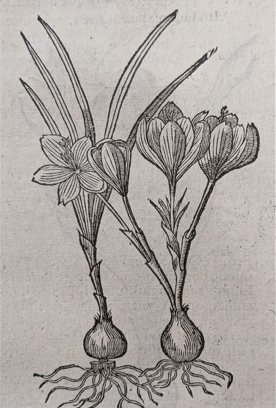
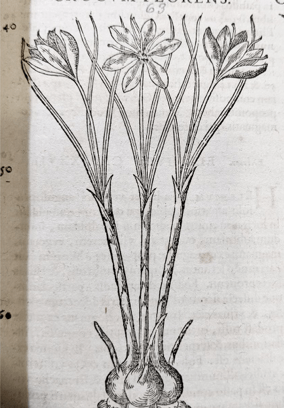
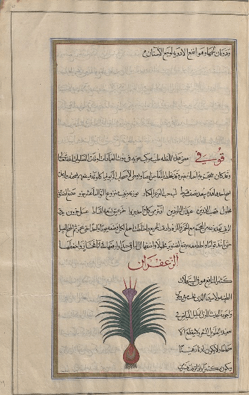
Image 2 from Mattioli, Pietro Andrea, Jean Ruel, Vincenzo Valgrisi, Christoph Albinus, and Dioscorides Pedanius. 1558. Petri Andreae Mattholi Senensis serenissimi principis … Commentarii secundo aucti, in libros sex Pedacii Dioscoridis Anazarbei De medica materia. Venetiis: Ex Officina Erasmiana, Vincentii Valgrisii. UCSF Library
Image 3 from al-ʻIbādī, Ḥunayn ibn Isḥāq, Mihrân ibn Mansûr, and Dioscorides Pedanius of Anazarbos, 1889-1890. De materia medica by Pedanios Dioscorides of Anazarbos (Kitāb Hash-ish), Spencer Collection, The New York Public Library. The New York Public Library
Patron: Nāṣir al-Dīn Shāh, Shah of Iran, 1831-1896
I chose a triptych for the visual presentation as it was an object of reverence in medieval times and the format allows for storytelling. In my triptych, I used the various abstracted silhouettes alongside my digitized hand-printed patterns developed using the marbling technique; a plant-based printing method from late medieval Iran. Marbling also references those decorative papers with mottled and marbled designs that were used for manuscripts’ binding throughout the history of book-making, particularly in medieval periods.
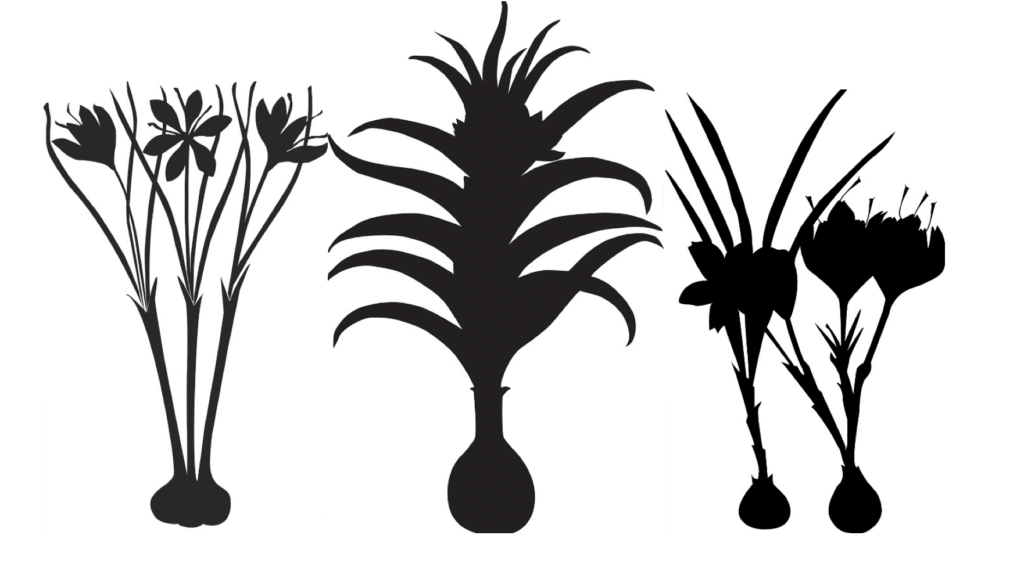

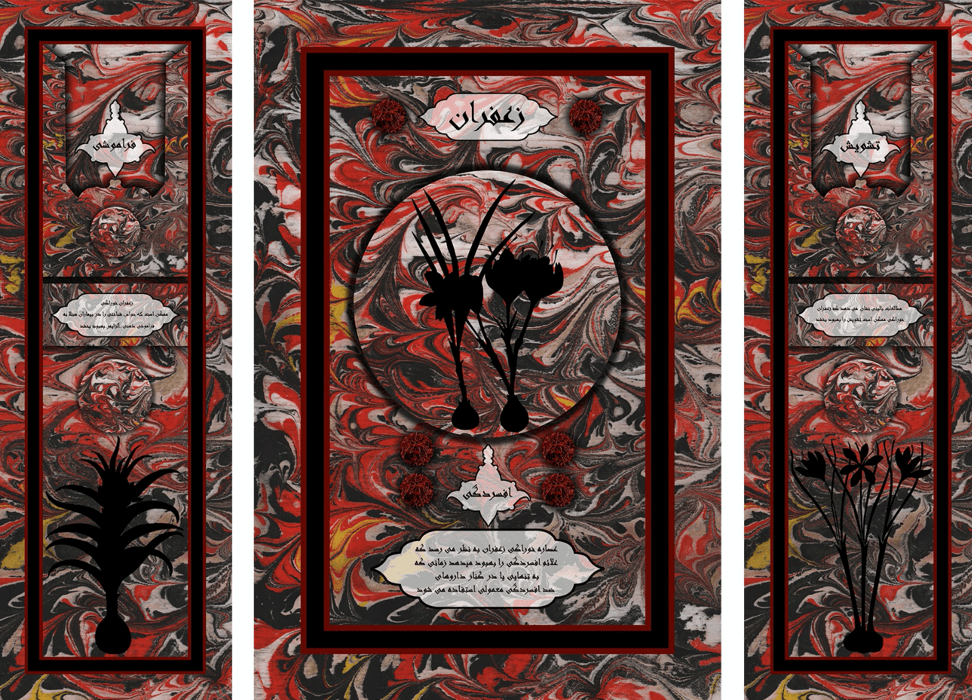
The text accompanying these visuals describes the medicinal healing properties of the saffron crocus in the Persian language. Translation and sources/references of the healing properties displayed on the triptych are as follows:
Left panel: Alzheimer‘s. Oral saffron might modestly improve cognition in patients with Alzheimer’s.
- 17401 Akhondzadeh S, Sabet MS, Harirchian MH, et al. A 22-week, multicenter, randomized, double-blind controlled trial of Crocus sativus in the treatment of mild-to-moderate Alzheimer’s disease. Psychopharmacology 2010;207:637-43.
- 105617 Ayati Z, Yang G, Ayati MH, Emami SA, Chang D. Saffron for mild cognitive impairment and dementia: a systematic review and meta-analysis of randomised clinical trials. BMC Complement Med Ther. 2020;20(1):333.
Right panel: Anxiety. Small clinical studies suggest that oral saffron might improve anxiety.
- 100137 Milajerdi A, Jazayeri S, Shirzadi E, et al. The effects of alcoholic extract of saffron (Crocus satious L.) on mild to moderate comorbid depression-anxiety, sleep quality, and life satisfaction in type 2 diabetes mellitus: A double-blind, randomized and placebo-controlled clinical trial. Complement Ther Med. 2018;41:196-202.
- 93404 Mazidi M, Shemshian M, Mousavi SH, Norouzy A, Kermani T, Moghiman T, Sadeghi A, Mokhber N, Ghayour-Mobarhan M, Ferns GA. A double-blind, randomized and placebo-controlled trial of Saffron (Crocus sativus L.) in the treatment of anxiety and depression. J Complement Integr Med. 2016 Jun 1;13(2):195-9.
Middle panel: Depression. The oral saffron extract seems to improve symptoms of depression when used alone or as an adjunct to conventional antidepressants.
- 11024 Akhondzadeh S, Fallah-Pour H, Afkham K, et al. Comparison of Crocus sativus L. and imipramine in the treatment of mild to moderate depression: A pilot double-blind randomized trial [ISRCTN45683816]. BMC Complement Altern Med 2004;4:12.
- 13103 Akhondzadeh S, Tahmacebi-Pour N, Noorbala AA, et al. Crocus sativus L. in the treatment of mild to moderate depression: a double-blind, randomized and placebo-controlled trial. Phytother Res 2005;19:148-51.
- 72434 Moshiri, E., Basti, A. A., Noorbala, A. A., Jamshidi, A. H., Hesameddin, Abbasi S., and Akhondzadeh, S. Crocus sativus L. (petal) in the treatment of mild-to-moderate depression: a double-blind, randomized and placebo-controlled trial. Phytomedicine. 2006;13(9-10):607-611
- 93399 Hausenblas HA, Saha D, Dubyak PJ, Anton SD. Saffron (Crocus sativus L.) and major depressive disorder: a meta-analysis of randomized clinical trials. J Integr Med. 2013 Nov;11(6):377-83.
- 93404 Mazidi M, Shemshian M, Mousavi SH, Norouzy A, Kermani T, Moghiman T, Sadeghi A, Mokhber N, Ghayour-Mobarhan M, Ferns GA. A double-blind, randomized and placebo-controlled trial of Saffron (Crocus sativus L.) in the treatment of anxiety and depression. J Complement Integr Med. 2016 Jun 1;13(2):195-9
- 100140 Tóth B, Hegyi P, Lantos T, et al. The efficacy of saffron in the treatment of mild to moderate depression: A meta-analysis. Planta Med. 2019;85(1):24-31.
- 103928 Akhondzadeh S, Mostafavi SA, Keshavarz SA, Mohammadi MR, Hosseini S, Eshraghian MR. A placebo controlled randomized clinical trial of Crocus sativus L. (saffron) on depression and food craving among overweight women with mild to moderate depression. J Clin Pharm Ther. 2020;45(1):134-143.
- 103931 Dai L, Chen L, Wang W. Safety and Efficacy of Saffron (Crocus sativus L.) for Treating Mild to Moderate Depression: A Systematic Review and Meta-analysis. J Nerv Ment Dis. 2020;208(4):269-276.
Artwork 2. Cube sculpture
It has been my long-lasting desire to transform these beautiful botanical images into the 3D form. During my residency at the UCSF Library, the idea materialized. The UCSF Library has a well-equipped Makers Lab where I ideated a second artwork that involved 3D modeling and 3D printing. The 3D saffron crocus plant was manufactured in collaboration with the UCSF Library Makers Lab team. Makers Lab Designer, Scott Drapeau, worked with me to envision the flower in 3D form. The process took around three months and the plant went through a few rounds of trial and error but eventually exceeded our expectations. Scott was skillfully able to make the flower from a 2D digital version I provided to him using the Blender software. I placed the 3D saffron crocus plant , which is modeled after the illustration in Mattioli’s book, at the UCSF Library inside a hand-made black cube that has four slits, one on each side. The plant is illuminated from the ceiling of the cube. A viewer has to look through one of the slits to see the flowering plant.
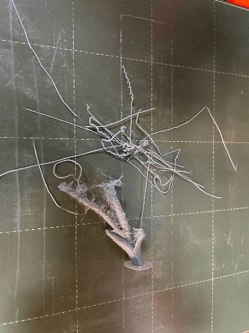
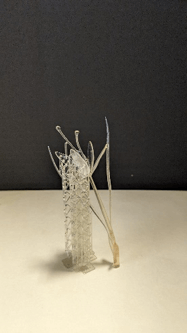
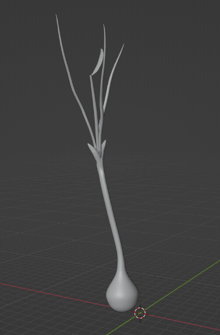
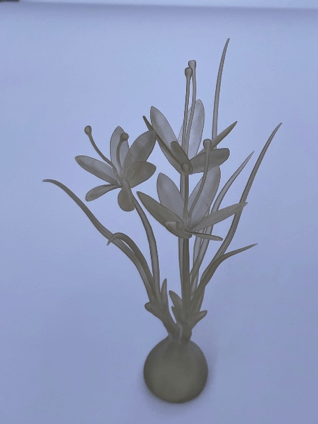
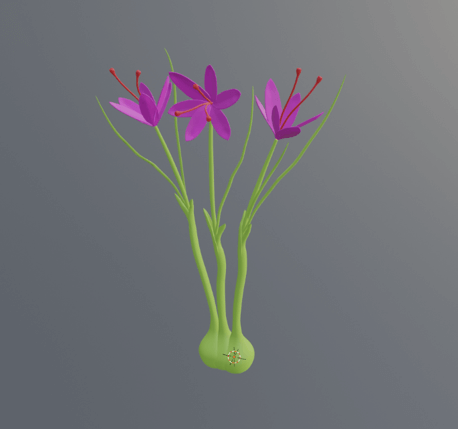
I had to determine the size of the hand-made cube sculpture appropriate to the height of the saffron crocus plant, and the width of the slits. It took me a few weeks, and four cardboard prototypes to determine the final size. The images below are from the sculpture creation process in my studio.
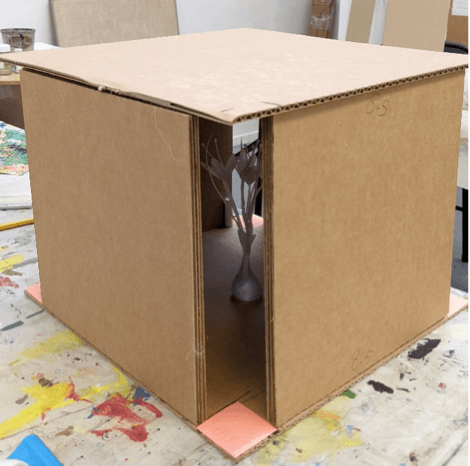
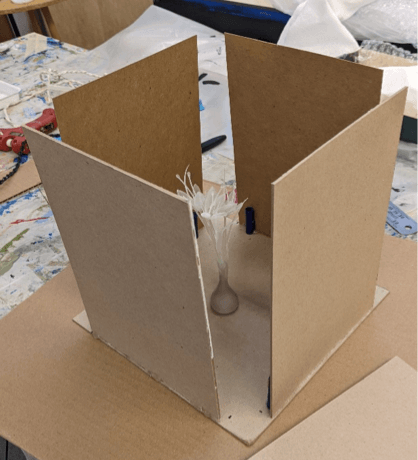
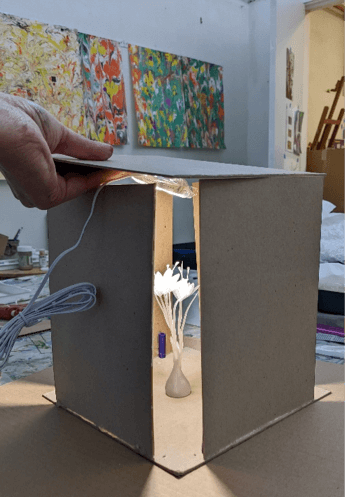
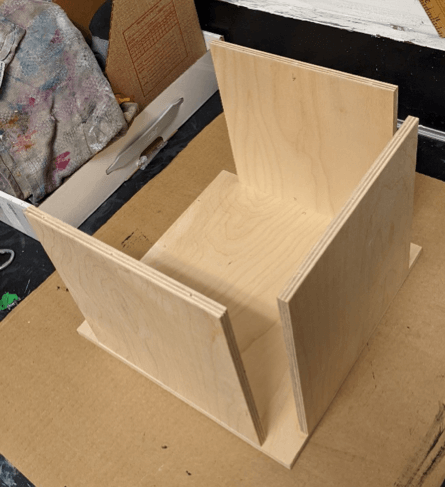
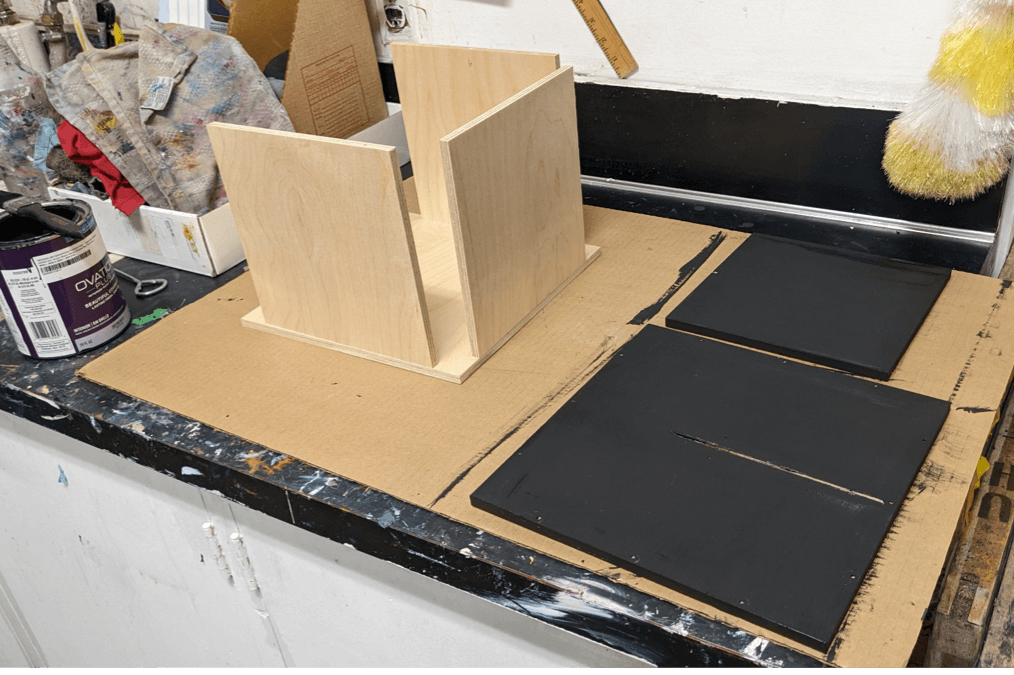
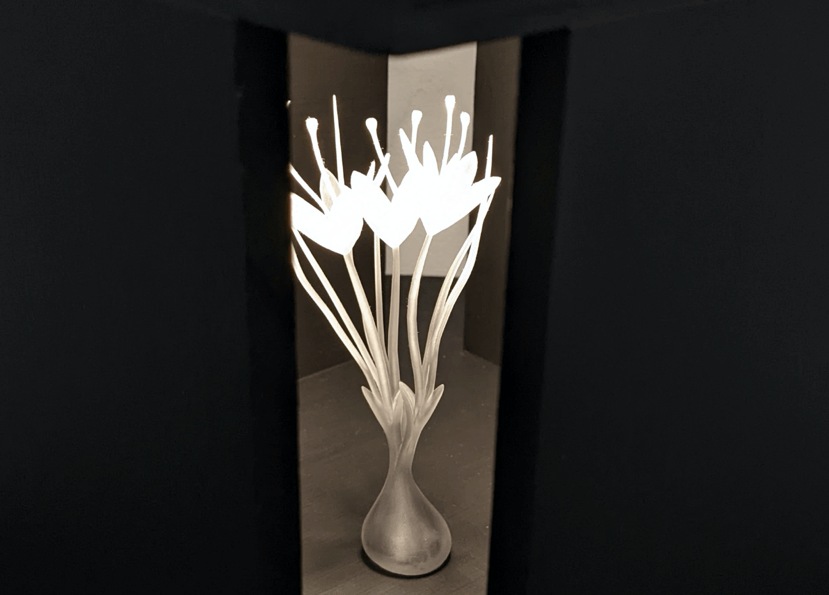
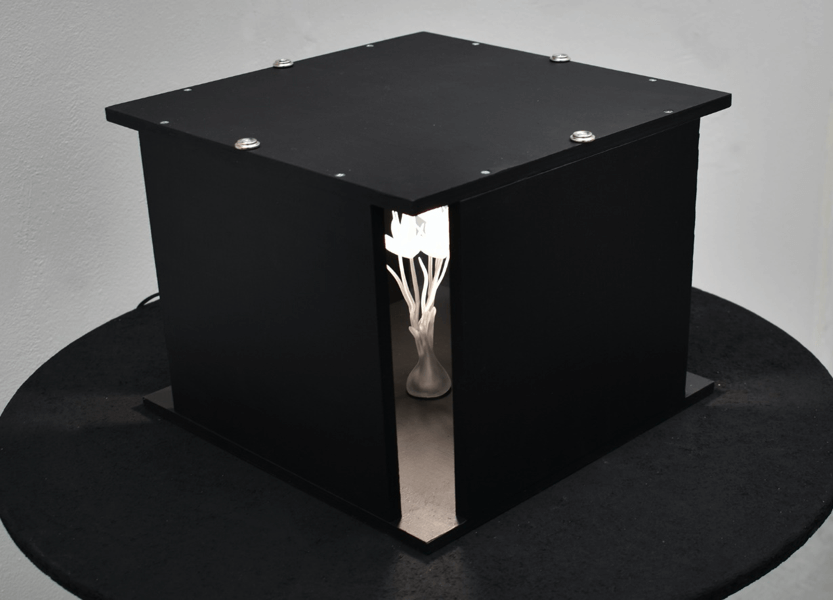
Artwork 3. Embossed prints
During my residency, I thought to create a series of embossed prints using the Crocus sativus silhouettes. With the help of Jenny Tai, Makers Lab Engineer, I laser-cut a few versions of Crocus sativus silhouettes on the Glowforge laser cutter using paper, plexiglass, and cardboard. The other two works took most of my allocated time for the residency project, so in the last few months of my residency, I didn’t get a chance to produce the embossed prints. Here is a snapshot view of the laser-cut flowers that I was going to use for my printing project.
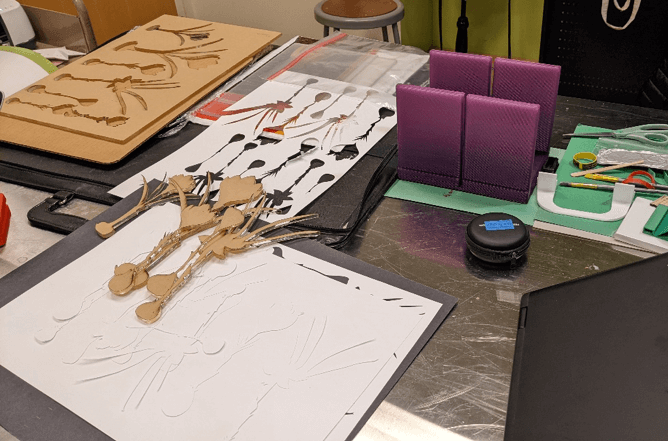
Here are some images of the installation day at the UCSF Library. I am very grateful to the Makers Lab and the Library staff, Dylan Romero, Polina Ilieva, Kirk Hudson, Jenny Tai, Scott Drapeau, and Peggy Tran-Le for their support through the end. This residency was truly wonderful and productive for me.
